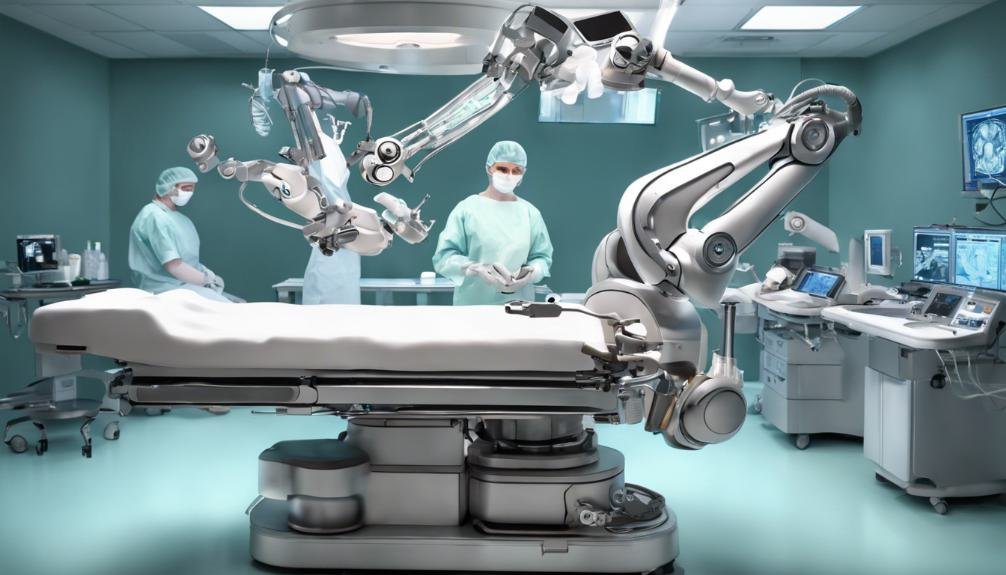AI in Orthopedic Surgery
In orthopedic surgery, AI's impact is reshaping traditional approaches, offering unparalleled precision and personalized care. Imagine a future where intricate procedures are guided by intelligent systems, optimizing outcomes with unmatched accuracy. The integration of AI technologies has opened new avenues for innovation in orthopedic surgery, paving the way for a more efficient and effective patient care landscape.
Key Takeaways
- AI aids in precise implant placement during surgery.
- Machine learning algorithms reduce surgical errors.
- Predictive analytics optimize treatment plans.
- Robotic assistance enhances surgical precision.
- Real-time analysis improves patient outcomes.
AI Applications in Orthopedics
AI plays a pivotal role in revolutionizing orthopedic surgery through its advanced applications in preoperative planning, intraoperative assistance, and postoperative monitoring.
In the field of AI diagnostics, predictive analytics have emerged as powerful tools for evaluating patient data to forecast outcomes and complications. These predictive models aid in customizing treatment plans for individuals, optimizing surgical procedures, and enhancing patient care post-surgery.
Furthermore, robotic-assisted surgeries have seen a surge in popularity within the orthopedic field. Through the integration of AI algorithms, these systems offer precise guidance to surgeons during procedures, resulting in improved accuracy and reduced risks.
Virtual simulations, enabled by AI technology, allow orthopedic surgeons to practice complex surgeries in a virtual environment before performing them on actual patients. This simulation-based training enhances surgical skills, decreases operating times, and minimizes errors during real surgeries.
Preoperative Planning Enhancements
Enhancements in preoperative planning within orthopedic surgery leverage advanced AI technologies to optimize surgical strategies and outcomes. Surgical simulation plays a key role in this process, allowing surgeons to virtually map out procedures before entering the operating room. By utilizing predictive analytics, AI can assist in determining the most effective approach based on patient-specific data and past outcomes.
Virtual reality (VR) is another vital tool in preoperative planning enhancements. VR technology enables surgeons to immerse themselves in a 3D model of the patient's anatomy, providing a more detailed understanding of the surgical site. This aids in identifying potential challenges and developing precise strategies to overcome them.
Image recognition algorithms further enhance preoperative planning by accurately analyzing medical images such as X-rays, MRIs, and CT scans. These algorithms can detect subtle details that might be overlooked by the human eye, contributing to more accurate surgical plans.
To conclude, the integration of AI technologies like surgical simulation, predictive analytics, virtual reality, and image recognition is revolutionizing preoperative planning in orthopedic surgery, leading to improved patient outcomes.
Intraoperative Assistance With AI
You can rely on AI for precise tool positioning during orthopedic surgeries, ensuring accuracy and efficiency.
AI solutions can also detect errors in real-time, alerting surgeons to potential issues before they escalate.
This intraoperative assistance with AI enhances surgical outcomes and contributes to overall patient safety.
Ai-Guided Tool Positioning
During orthopedic surgeries, the precision and accuracy of tool positioning can be greatly enhanced through the utilization of AI-guided assistance. Robot-assisted navigation systems play a crucial role in achieving this precise guidance. These systems integrate advanced AI algorithms to assist surgeons in positioning tools with utmost accuracy during procedures.
AI-guided tool positioning involves the real-time tracking of surgical instruments and implants. Through continuous feedback and analysis of intraoperative data, the AI system provides guidance to guarantee excellent placement of tools. By leveraging machine learning algorithms, the system can adapt to variations in patient anatomy and surgical conditions, enhancing overall surgical outcomes.
The AI-guided assistance not only aids in tool positioning but also contributes to reducing surgical errors and improving efficiency in the operating room. Surgeons can rely on the AI system to navigate complex anatomical structures and achieve precise placement of implants with minimal margin of error.
Real-Time Error Detection
Real-time error detection during orthopedic surgeries is greatly enhanced with the integration of AI systems, providing essential intraoperative assistance to surgeons. Machine learning algorithms analyze real-time data and images to detect anomalies, offering immediate feedback to prevent potential errors.
Through sophisticated image analysis, AI can identify subtle changes in surgical procedures that may indicate deviations from the best surgical plan.
Predictive analytics play a vital role in anticipating potential errors before they occur, allowing for proactive adjustments during the surgery. By continuously monitoring the surgical process, AI systems can provide predictive insights based on historical data and ongoing observations. This enables surgeons to make informed decisions in real-time, enhancing the overall surgical outcome.
Furthermore, AI-powered surgical navigation systems offer precise guidance and visualization, aiding surgeons in maintaining accuracy throughout the procedure. By integrating AI technologies into orthopedic surgeries, real-time error detection becomes a valuable tool for enhancing surgical precision and patient safety.
Postoperative Care Optimization
Optimize postoperative care in orthopedic surgery by implementing advanced AI-driven monitoring systems. Remote monitoring plays an essential role in tracking patients' recovery progress outside the hospital setting. AI algorithms can analyze real-time data from wearable devices, providing insights into vital signs, activity levels, and potential complications. By leveraging remote monitoring, healthcare providers can intervene promptly if any issues arise, improving patient outcomes and reducing readmission rates.
Telemedicine consultations further enhance postoperative care by enabling healthcare professionals to communicate with patients virtually. Through video calls or messaging platforms, orthopedic surgeons can assess patients' conditions, address concerns, and provide guidance on rehabilitation exercises. This remote approach minimizes the need for in-person visits, making healthcare more accessible and convenient for patients recovering from orthopedic surgeries.
AI-driven Surgical Precision
Implementing AI-driven technologies enhances surgical precision in orthopedic procedures by enabling real-time analysis of anatomical structures and assisting surgeons in making accurate decisions during operations.
Robotic assistance plays an essential role in achieving higher surgical accuracy by providing steady, controlled movements that surpass human capabilities. These robotic systems are equipped with advanced algorithms that leverage machine learning to adapt to the patient's anatomy, allowing for precise incisions and implant placements.
Furthermore, AI algorithms aid in clinical decision-making by analyzing vast amounts of preoperative data, such as imaging scans and patient history, to provide real-time guidance to surgeons. By integrating machine learning into the surgical workflow, orthopedic procedures benefit from reduced human error and improved patient outcomes.
The synergy between robotic assistance and AI-driven technologies not only enhances surgical precision but also contributes to the overall efficiency and safety of orthopedic surgeries. This integration marks a significant advancement in the field, promising a future where surgical interventions are characterized by unparalleled accuracy and reliability.
Efficiency Improvement in Procedures
To enhance the overall efficiency of orthopedic procedures, incorporating AI technologies streamlines surgical processes and optimizes resource utilization. Workflow streamlining is achieved through the utilization of AI algorithms that assist in pre-operative planning, intra-operative guidance, and post-operative monitoring. These systems analyze vast amounts of patient data, including imaging scans and medical records, to provide surgeons with real-time insights and decision support, leading to improved surgical accuracy.
Time-saving techniques facilitated by AI include automating routine tasks such as documentation, scheduling, and inventory management. By reducing the time spent on administrative duties, healthcare providers can focus more on patient care and complex surgical procedures.
Technological advancements in AI also enable predictive modeling for surgical outcomes and complication risk assessment, allowing for proactive intervention and personalized treatment plans.
Enhanced Patient Outcomes
By leveraging AI technologies in orthopedic surgery, patient outcomes can be greatly enhanced through personalized treatment strategies and proactive intervention. AI algorithms can analyze vast amounts of patient data to tailor treatment plans specific to each individual, leading to improved recovery times and outcomes post-surgery.
Through real-time monitoring and predictive analytics, AI can identify potential complications early on, allowing for timely interventions and reducing the risk of adverse events.
One of the key benefits of AI in orthopedic surgery is the enhancement of mobility for patients. By utilizing AI-powered rehabilitation protocols, healthcare providers can customize rehabilitation programs based on each patient's progress and needs, ultimately leading to improved mobility outcomes.
AI can also assist in predicting best recovery timelines, enabling patients to regain functionality more efficiently and effectively.
Conclusion
In summary, AI in orthopedic surgery is like having a skilled navigator guiding a ship through treacherous waters.
With predictive analytics, robotic assistance, and personalized treatment strategies, AI guarantees smoother sailing towards ideal patient outcomes.
Just as a captain relies on a compass to steer the ship in the right direction, surgeons can trust AI to provide them with the necessary insights and support to navigate complex surgical procedures with precision and efficiency.







